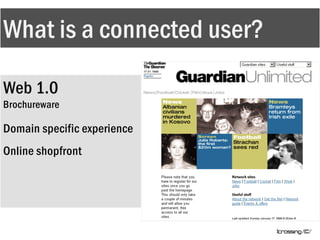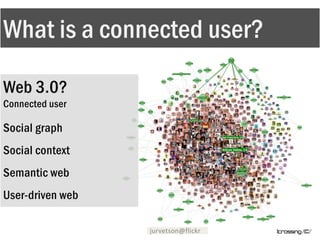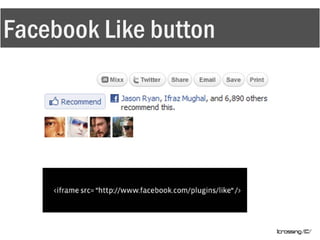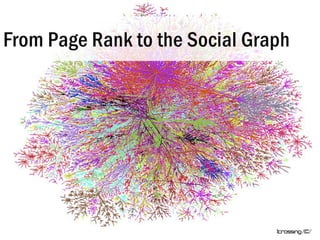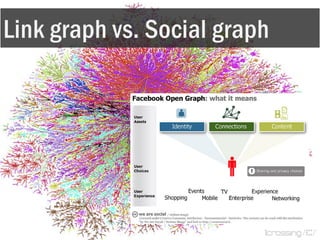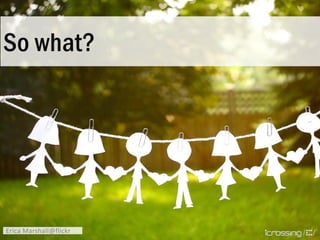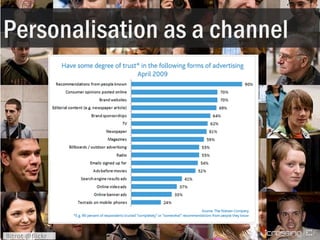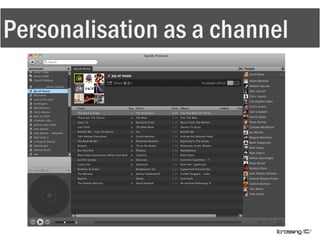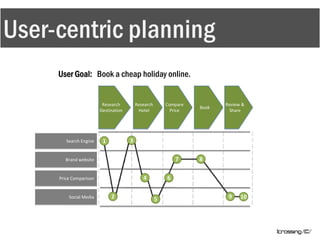The Connected User - iCrossing Client Event May 2010
- 1. The Connected UserRoyal Opera House :: 7th May 2010Jason RyanNilhan JayasingheErica Marshall@flickr
- 2. What is a connected user?Web 1.0 Brochure wareDomain specific experienceOnline shopfront
- 3. What is a connected user?Web 2.0Connected webContent distribution toolsUser in control of UINetwork of experiencesConnected brandseuskeratsky@flickr
- 4. Digg – a distributed brand experience
- 5. What is a connected user?Web 3.0?Connected userSocial graphSocial contextSemantic webUser-driven webjurvetson@flickr
- 12. Whose data is it?Good news for FacebookUsers – data privacy ?Site owners (brands/organisations) – what is in it for them ?
- 13. From Page Rank to the Social Graph
- 14. Links: a limited view Troubled linksRich get richerEasy to spamAmbiguity and contextSubjectivityPublisher vs. searcher
- 15. New signals…The Vince UpdateUser data Semantic relationshipsNew search signals
- 17. Google knows youPersonalised searchWhat I meanWho I knowWho I like
- 18. The Social Graph
- 19. What your friends are saying?Social SearchRecommendationDissatisfactionEngagement
- 20. Real-time searchGoogle integrationTwitter hot topics
- 22. Link graph vs. Social graph
- 24. Personalisation as a channelBitrot @flickr
- 25. Personalisation as a channel
- 26. Personalisation as a channel
- 27. User-centric planningUser Goal: Book a cheap holiday online.Research DestinationComparePriceResearchHotelBookReview &ShareSearch Engine31Brand website78Price Comparison64Social Media29105
- 30. What does it mean?Visibility is about more than SEOUser data will redefine how we discover contentPage Index (Google) vs. User Index (Facebook)Next generation web architecture ?
- 31. What does it mean for brands?The bad news…Rapid innovationA moving targetThe good news…Take the user view - underlying motivations do not changeListen and measureClient/agency partnershipsDorgunnurDorsdottir@flickr
- 32. Putting it in perspective1/3 of all search queries are Navigational1/3 of all search queries are Commercial1/3 of all search queries are Informational400M+ Facebook users vs. 20B+ pages indexed by Google Links will always be a signal‘Blue Hat’
- 33. Questions to ask…Do we know where our customers are?Are we listening to them?Are they likely to discuss, link to and ‘like’ our content?Are we building relationships and connections?Are we planning in silos or across teams?How are we measuring success?
- 34. Thank youjason.ryan@icrossing.co.uk / @jasonryannilhan.jayasinghe@icrossing.co.uk / @nilhanErica Marshall@flickr
Editor's Notes
- Answering this question as a UX practitioner, from a user perspective,it is about the evolution of the web from a passive publishing/advertising platform to an increasingly user-driven social space. We have all aware of the profound changes that the social web have brought, and the change in user behaviourBack in the early days of the web, brands/publishers were completely focussed on the content and user experience of their own property or domain – their web site, in fact their home page, was their shopfront in the online world, and they imagined readers/visitors coming in through their front door or home pageIn fact it was search engines, that brought users through to deeper level pages that helped to break down this real world thinking-
- But with web 2.0 - the connected web – there was an explosion of content creation, distribution and aggregation tools - RSS, mobile devices, news aggregation sites, and start pages have all meant that users increasingly have control over the content they consume and the interfaces they choose to view it throughBrands began to recognise that their domain sites were just a part of their online presence, and distributed UX and content strategies became increasingly importantWe are seeing a shift away from the site-centric brand experience as many brands begin to create a consistent online presence across multiple platforms and devicesAt iCrossing we have been talking about Connected brands for some time – those that are visible, useful, usable, desirable and engaged; those that understand that their customers navigate and communicate online via networks
- It is the emergence of the social graph, the rich network of relationships between people, that has given rise to the idea of a connected user. And this is beginning to have a profound effect on the way we think abut the web – the way we design our interfacesthe effect it has had on the Google algorithm and how we plan our search activity the rise of social media and the increasing importance of user engagement. User data is no longer just about the pages that people own or visit, but about the rich and complex connections to both content and other people
- Recently Facebook moved everything on a quantum leap with its recent announcement of the Open Graph API, and its suite of social media plug-ins that sit on top of the Open Graph.The Open Graph or Social Graph is a map of connections between people and content
- FB Like perhaps the simplest but most profound of the pluginsCNN – Activity Feed shows me who in my FB network has liked content on the site. Don’t need to be logged in.Can see Jonny Stewart has recommended this article – ‘Google’s nightmare’When I go to the page, I can see that Ifraz, Jonny and Chris have all recommeded this article.
- In terms of usability, this is the simplest action – a simple vote – there is very little barrier to overcome from a user perspective. A ‘like’ will publish the content to my FB NewsFeed, whilst helping FB to build a contextual social index over the webThe like Button was added to some 50,000 pages in the first weekWith the Like button, FB has began to colonise the web, potentially allowing FB functionality to be brought to every page. This isnt necessarily a new idea - Digg etc. have been doing this for a while, but with FB's 450M user base and social graph information, compared to Diggs 3M - this has effectively changed overnight the way we find and encounter our content
- FB announced the new open graph api and social media plugins with 30 partners including CNN, WSJ, Sky and some retailers including levi.coms
- So this is great news for Facebook – but what about users, and what about brands? Who owns the data?Before joining iCrossing, I did a lot of work with museums like the BM and MoMA. It was difficult for those institutions to track user preferences for their collection without building personal collection systems that were expensive, were institution specific and required registration and login.Consequently the community was distributed and there was little take up.Now with a simple LIKE button, a simple standard has been created with an immediate memberhsip of 450M. So potentially now, the data can be collected. That is great news for Facebook - but what about institutions, brand owners ? whose data is it?In FB’s own words ‘Its complicated’ – and it is not the time or place to get into that debate now – but is something to be aware of and worth looking into FB data policy to understand the implications.Generally speaking, privacy policies and statements are in need of some user centric design - those that innovate in this area, understanding user concerns, and laying this out in simple terms can gain some credibility and trustThe implications for brands is that this could help them build much larger audiences on Facebook. However, as numbers increase, brands will increasingly need to look beyond "number of fans" and into deeper metrics around engagement and e-commerce.
- Google’s PageRank assumes a web of documents. A connectivity score determines the reputation and relevanceProvided a scalable and efficient solution for retrieving a page of results
- The link graph allows the published web to determine relevanceUntil very recently, a query such as ‘tables’ didn’t return any documents about furniture within the organic results. There’s a disconnect between the published web which didn’t contain a lot of content about furniture and the majority of searches who are in fact looking for furniture.The link graph failed such queries.It also fails where queries require a subjective answer
- The Google Vince update, nicknamed the brand update by the SEO community attempted to solve the disconnect between the published web and the user by including user data.By aggregating and analysing the query refinements, Google can see that a lot of people specify furniture following a general query for ‘table’ – many even search by brand / vendor (i.eIkea). So it makes sense for Google to include results for furniture even if such content isn’t as prominent on the web as some of the other types of tables such as ‘html’, ‘Premiership’, ‘Periodic’ and ‘Database’Another characteristic of the Vince Update was the inclusion of semantic analysis. Using a similar technology to Latent Semantic Analysis, Google can determine relationship between words based on their statistical co-occurrence. Using the special character (~) – we can see that BMW is synonyms with ‘car’. The SEO community thought Google favoured brands, because organisations such as British Airways started to rank for terms such as ‘flights’ which they weren’t particularly well optimised for. The fact is, BA appears on a lot of web pages and links near the words flights. And a lot of people refine their search for ‘flights’ with ‘british airways’ These two signals are enough for Google to know that a www.britishairways.com/is a good results for ‘flights’
- Since the Vince update – Ikea and Mydeco appear high up on the first page of Google for Tables. Neither of these sites can compete using a pure link graph. But, the inclusion of the user signal has enabled them to rank.
- The general user signal still leaves plenty of room for ambiguity. Google knows your web and search history. Combining these provides more relevant results. The screenshot shows the impact of personalisation for a search on ‘bmi’. A generalised results returns British Midland International at position 1. But, by building a web history with the body mass index calculator (previously ranking 5), it appears at the top of results.All results are now personalised based on a cookie. For brands, building a relationship with customers and potential customers, through returning visits and engagement – is key.Its about ranking high within the personal search channel – not appearing high for everyone.
- For subjective queries it makes sense to provide results from your social circle. Our social graph is public (Twitter followers) but Google can also access more private data such as your Gmail contacts.
- For certain queries (in this case a search for ‘ipad’) Google is including results from your online social circle.So far results from friends and friends of friends are included.Huge implications for marketers, through advocacy and recommendations as we’ll as the customer service challenges from dissatisfaction and the inevitable reputation management concerns
- Google includes realtime data for trending topics within regular results. Some say a panic response to competition from real-time engines for certain queries. Google’s crawler based index can not keep up with Twitter and FB. Initially tweets were included without much filtering – but increasingly we are seeing similar reputation algorithms being applied to those used for the web index as well as the follower numbers. We have also seen the inclusion of not just tweets but the content that is being tweeted about (Videos, News items etc...). Distributing useful and engaging content to your network, seems the simplest way to be part of the conversation.
- The new Google interface is recognition of the emergence of a user driven pseudo semantic web. The navigation is dynamically generated with content types based on the query.
- Both Google andFacebook emerged out of University. Google concentrated on organising the academic content while Facebook set out to index the social context.Google essentially believed the web is a web of documents and added user and social signals on top of the link graph.Facebook treats the web as essentially people where content like your identity and connections are in fact another facet of you.Google uses software to crawl the web.Facebook uses the social graph to discover content – you are the crawlerIn the FB world content can not exist unless it is connected to the social graph.In that sense all the content within FB has a much richer meaning and context. Even if it’s much much less comprehensive.
- Nielsen study – recommendations from peers has most influenceImportance of personalisation/recommendations as a trusted advertising channelContent providers and advertisers/brands will increasingly need to position themselves in the personal feed and recommendationsQuestion as to how much of the social graph is influential right nowThis is early days – this will become more sophisticated – and will become more like the real world - we will start to follow people who can provide value to us through their knowledge and recommendations (fashion, music, books, film etc.) – taste agents
- At icrossing, our response to this is to try to plan across search, social and creative – by understanding objectives and synergies across all areas – and putting user centric measurement and evaluation at the heartFor example, creative that is designed for visibility and engagement – with clear KPIs and targets outlines and trackedOr search strategies that are enhanced by social media activity and improved user experience
- User-centric evaluation framework
- Visibility is now about more than seo, it is understanding that the indexes for the social web are being built - and that user/social data will redefine the way we find and discover contentGoogle have compiled a page index of the web as a basis for search engines and now FB are compiling a people/user index that maps complex relationships to people and content that tracks your user journey across the web – are we seeing FB challenging Google for control of the webIf user data is the new oil then FB are sitting on some rich reservesStarting to see the next generation architecture of the web
- What does this mean for brands?The bad news – or the challenge – is the complexity and speed of innovation; it can seem like a moving target trying to stay on top of these developmentsThe good news is that by taking a user view and accepting that the underlying user motivations and behaviours do not change whilst platforms/services and companies will come and goBy understanding that users exist in networks – and it is important to listen to, and being present in those networks, and setting measures of success for your activityIt is a challenging time for both brands and agencies – but a solid client/agency partnership where learning, innovation and evaluation is on the agenda will help
- Doubt if there will be a better way to navigate content than GoogleGoogle will always be more comprehensive.But, the open graph may just have the content that we care more about – things we are more passionate about and emotionally engaged with.

